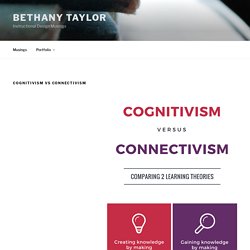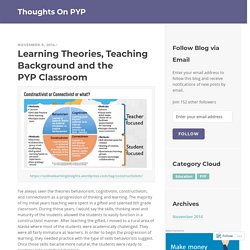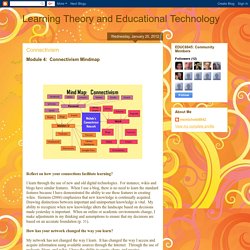

Cognitivism vs Connectivism. Learning Experience of Social Cognitivism The best example of learning based on social cognitivism is learning to play Tenor Saxophone in public school band.

Much of my learning was observing and processing what I was observing into behavioural adoptions. When I wasn’t quite understanding the organisation of the fingers for a note or the proper mouth position, the instant reinforcement would come from the sound of my instrument (in comparison to the rest of the band). I would then need to create or invent a new way of presenting what I had observed to see if I had gotten back to the original observed result. Learning Experience of Connectivism My recent experiences with learning more about learning and development has included a wide range of connectivism. References Bruner, J. Bruner, J. Cognitive Load Theory: Making Learning More Effective. McLeod, S. (2011, January 01). Siemens, G. (2005, January). Smith, M. Learning Theories, Teaching Background and the PYP Classroom – Thoughts On PYP. I’ve always seen the theories behaviorism, cognitivism, constructivism, and connectivism as a progression of thinking and learning.

The majority of my initial years teaching were spent in a gifted and talented 6th grade classroom. During those years, I would say the skills, thinking level and maturity of the students allowed the students to easily function in a constructivist manner. After teaching the gifted, I moved to a rural area of Alaska where most of the students were academically challenged. They were all fairly immature as learners. In order to begin the progression of learning, they needed practice with the type of skills behaviorists suggest. In my current school, and PYP program, the students are very skilled at thinking and problem solving. 5th graders who have been acquiring knowledge by problem solving and discovery for years can easily handle the challenge of connectivist methods of learning.
Like this: Learning Theory and Educational Technology: Connectivism. Module 4: Connectivism Mindmap Reflect on how your connections facilitate learning?

I learn through the use of new and old digital technologies. For instance, wikis and blogs have similar features. When I use a blog, there is no need to learn the standard features because I have demonstrated the ability to use these features in creating wikis. Siemens (2006) emphasizes that new knowledge is continually acquired. My network has not changed the way I learn. Which digital tools best facilitate learning for you? Digital tools that best facilitate my learning are: · Wikis · Skype · Blogs · Iphones All of these digital tools allow me to access information anytime and anywhere. How do you learn new knowledge when you have questions? When I have questions, I use Google and other search engines on the Internet in order to research appropriate and reliable sources.
Elements of Connectivism. Broadcast Yourself. Connectivism. My Learning journal as a teacher. Connectivism: A Learning Theory for the Digital Age. Connectivism: A Learning Theory for the Digital Age December 12, 2004 George Siemens Update (April 5, 2005): I've added a website to explore this concept at www.connectivism.ca Introduction Behaviorism, cognitivism, and constructivism are the three broad learning theories most often utilized in the creation of instructional environments.

Learners as little as forty years ago would complete the required schooling and enter a career that would often last a lifetime. “One of the most persuasive factors is the shrinking half-life of knowledge. Some significant trends in learning: Many learners will move into a variety of different, possibly unrelated fields over the course of their lifetime. Background Driscoll (2000) defines learning as “a persisting change in human performance or performance potential…[which] must come about as a result of the learner’s experience and interaction with the world” (p.11). Driscoll (2000, p14-17) explores some of the complexities of defining learning.